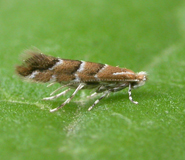Horse chestnut trees, whose solid conker seeds are responsible for hours of playground fun, are under siege from an alien moth which arrived in London in 2002.
Since then it has spread at a rate of 40 to 60 km per year and now covers half of the country, including much of south-central England, East Anglia, the Midlands and most recently Yorkshire and Cornwall.
Experts at the Universities of Bristol and Hull are now asking for the public’s help in monitoring this spread through a combination of new technology and old-fashioned science.
Ultimately, they want to understand the invasion better with a view to combating the damage caused by the alien moth.
A special mobile phone app has been devised to allow people to upload a photo of any horse chestnut leaves they come across, either with or without the indication of alien moths, which will pin-point their location and help to build up a picture of which areas are suffering from the infection.
Participants are also asked to collect a leaf from an infected tree and put it into a plastic bag before documenting the insects which emerge later in the month. This is to gauge how many are natural pest controllers, in the form of tiny parasitic wasps, that had killed the developing moths.
This is the largest project of its kind in the UK and is funded by the Natural Environment Research Council (NERC).
Dr Darren Evans from the University of Hull said: “The traditional game of conkers may be under threat, because trees infected with the alien moth produce smaller conkers.
“With this in mind, we’re inviting people from all parts of the country to see if horse chestnut trees in their area have been infested. The whitish blotches on horse chestnut leaves that appear during the early summer are an indication that the ‘alien’ moths have arrived in their area.”
This alien moth, a species not found in Britain until very recently, has caterpillars that live inside the leaves, forming distinctive patches of damage called ‘leaf mines’. Up to 700 leaf mines have been recorded on a single leaf and the damage caused by large numbers of larvae can be striking.
Severely damaged leaves shrivel and turn brown by mid summer and fall early, well before the autumn, giving the impression that the tree is dead.
Last year, over 3,500 people took part in the study which showed that the leaf-mining moth had spread from London and affected trees as far afield as Wales and the north of England, but there is no evidence of it having reached Scotland yet.
Dr Michael Pocock from the University of Bristol added: “This is an exciting opportunity for people to take part in a real scientific experiment on a national scale. It’s a big mission for which we’re reliant on the public’s help.
“We’ve developed the mobile phone app to make it even easier for people to take part and we’re hopeful that they will play their part in discovering more about the threat to the future of our much cherished conker trees.”
This year’s Conker Tree Science study will give the most up-to-date picture of the spread of the moth.
Verified records will then be passed to Forest Research to add to its national database, which has been recording the spread of the moth since its arrival in 2002.
To find out more and to take part in this important experiment, please visit the project's website.

